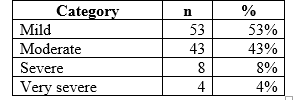Profile of patients with carpal tunnel syndrome: A study in a tertiary care hospital
Abstract
Background: Carpal tunnel syndrome (CTS) is one of the most common ‘peripheral neuropathy which is usually associated with the compression of the median nerve at the level of carpal tunnel. CTS is generally characterized by tingling, numbness, weakness of the thumb, and thenar atrophy. In Bangladesh, we do have not enough research-based data regarding the features and presentations of carpal tunnel syndrome.
Aim of the study: This study aimed to determine the features and demography of patients with carpal tunnel syndrome (CTS).
Methods: This prospective observational study was conducted in the Department of Physical Medicine & Rehabilitation, Cumilla Medical College Hospital, Cumilla, Bangladesh during the period from January 2019 to January 2020. In total 100 patients with carpal tunnel syndrome were included as the study subjects of this study. This study was approved by the ethical committee of the mentioned hospital. Proper written consent was taken from all the participants before data collecting. All data were collected, processed and analyzed by using MS Office and SPSS version 23 programs as per need.
Results: The mean (±SD) age of the participants was found 47.25±9.50 years. The male-female ratio was 1:3. The mean (±SD) BMI (kg/m2) was 26.9±4.77. Most of the participants were married which was 62% (n=62). We found paraesthesia weakness in thenar eminence, numbness, nocturnal pain, pain after physical activity and sensitivity alteration were associated in more than 75% of patients. Among all the participants, more than half (53%) of the patients were mild in condition. Besides this, 43%, 8% and 4%of patients were in moderate, severe and very severe condition respectively.
Conclusion: Women are most vulnerable to carpal tunnel syndrome. Most of the cases for CTS are found in the middle age group. Paraesthesia may be considered the most common symptom of this disease. Early diagnosis may reduce the suffering of patients with carpal tunnel syndrome.
Downloads
References
Pfeffer GB, Gelberman RH, Boyes JH, Rydevik B. The history of carpal tunnel syndrome. J Hand Surg Br 1988 Feb;13(1):28-34.
Aroori S, Spence RA. Carpal tunnel syndrome. Ulster Med J 2008 Jan;77(1):6-17.
Alfonso C, Jann S, Massa R, Torreggiani A. Diagnosis, treatment and follow-up of the carpal tunnel syndrome: A review. Neurol Sci 2010 Jun;31(3):243-52. DOI: 10.1007/s10072-009-0213-9. Epub 2010 Feb 10.
Paget J. Lectures on Surgical Pathology. 1854. Lindsay and Blakiston, Philadelphia.
Atroshi I, Gummesson C, Johnsson R, Ornstein E, Ranstam J, Rosen I. Prevalence of carpal tunnel syndrome in a general population. J Am Med Assoc 1999 Jul 14;282(2):153-8.
Mondelli M, Giannini F, Giachhi M. Carpal tunnel syndrome incidence in a general population. Neurology 2002 Jan 22;58(2):289-94.
Rask MR. Anterior Interosseous nerve entrapment: (Kiloh-Nevin syndrome) a report of seven cases. Clin Orthop Relat Res 1979 Jul- Aug;(142):176-81.
Phallen GS. The carpal-tunnel syndrome. Seventeen years experience in diagnosis and treatment of six hundred fifty-four hands. J Bone Joint Surg Am 1966 Mar;48(2):211-28.
National Institute of Neurological Disorders and Stroke (NINDS), Carpel Tunnel Syndrome Fact Sheet. [Cited on: January 2017]. Accessed from: http://www.ninds. nih.gov/disorders/carpel_tunnel/de tail_carpal_tunnel.htm#68963049.
Solomon L, Warwick DJ, Nayagam S. Apley's concise system of orthopedics and fractures. March 31, 2005. CRC Press, London. ISBN: 9781444165517.
Zyluk A, Kosovets L. An assessment of the sympathetic function within the hand in patients with carpal tunnel syndrome. J Hand Surg Eur Vol 2010 Jun;35(5):402-8. DOI: 10.1177/1753193409361292.
Dorwart BB. Carpa l tunnel syndrome: A review. Semin Arthritis Rheum 1984 Nov;14(2):134-40.
Krendel DA, Jobsis M, Gaskell PC Jr, Sanders DB. The flick sign in carpal tunnel syndrome. J Neurol Neurosurg Psychiat 1986 Feb;49(2):220-1.
de Azevedo JW, de Oliveira AB, Nascimento Vd, de Paiva HR Jr, Viecili L, Rocha MA. Profile of patients on sick leave with carpal tunnel syndrome. Acta Ortop Bras 2015 Sep-Oct;23(5):244-6. DOI: 10.1590/1413-785220152305145 784.
Sternbach G. The carpal tunnel syndrome. J Emerg Med 1999 May- Jun;17(3):519-23.
McCornick A, Fleming D, Charlton J. Morbidity statistics from general practice: Fourth National Study 1991-1992. London: H.M.S.O; 1995. Print.
Bahou YG. Carpal tunnel syndrome: A series observed at Jordan University Hospital (JUH), June 1999- December 2000. Clin Neurol Neurosurg 2002 Jan;104(1):49-53.
Al-Suleiman AA, Ismail HM. Carpal tunnel syndrome: A clinical and electrophysiological study of 220 consecutive cases at King Fahd Hospital of the University, Al-Khobar. Saudi Med J 1997;18(1):59-63.
Malibary HM, Al-Najjar AT, Yassen DM, Abuhussain HAA, Radhwi OO, Alfares ZR. Clinical profile of carpal tunnel syndrome in a teaching hospital. Pak J Med Sci 2013 Jan;29(1):119-21. DOI: 10.12669/ pjms.291.2946.
Awan AS, Khan A, Afridi SA, Khan IU, Bhatti SN, Ahmed E, et al. Early response of local steroid injection versus mini-incision technique in the treatment of carpal tunnel syndrome. J Ayub Med Coll Abbotabad 2015 Jan- Mar;27(1):192-6.
Abumunaser LA. Demographic pattern of carpal tunnel syndrome in western Saudi Arabia. Neuroscience (Riyadh) 2012 Jan;17(1):44-7.
Amir S, Qadir M, Usman M. Clinical profile of patients with carpal tunnel syndrome. Khyber Med Univ J 2018;10(1):36-39.



























